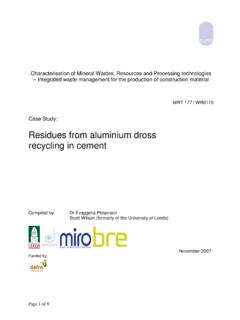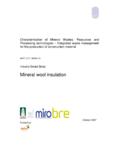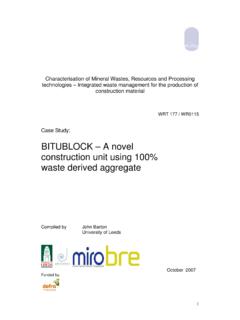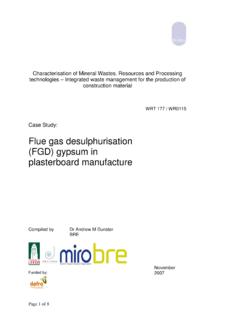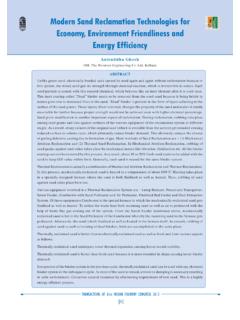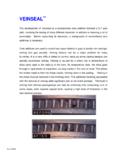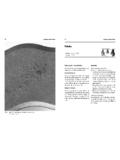Transcription of Brick foundry sand - SMARTWaste
1 Page 1 of 8 Characterisation of Mineral Wastes, Resources and Processing technologies Integrated waste management for the production of construction material WRT 177 / WR0115 Case Study: foundry sand in facing bricks Compiled by Dr Evaggelia Petavratzi Scott Wilson Funded by: November 2007 Page 2 of 8 Introduction foundry sand represents silica sand used in the production of moulds for ferrous and non-ferrous metal casting. It is estimated that the UK foundry industry uses and disposes of, over one million tonnes of foundry sand per year, with the majority arising in the Midlands, South and West Yorkshire1. Two variations of foundry sand are utilised to produce moulds into which metal is cast, greensand and chemically bonded sand .
2 Greensand is the most common type and it consists of silica sand , bentonite clay (~ 10% by weight), 2 to 5% water and about 5% coal dust (improves casting finish)2. Greensand is normally reused and can therefore contain burnt fines, coke residues and residual clays. Chemically bonded sand involves the use of organic and inorganic binders in conjunction with catalysts and different hardening/setting procedures. Three types of chemically bonded sand are normally used the: alkaline phenolic, furan and resin shell. The type of sand used is dependent upon factors such as the type and size of casting being produced1. This case study investigates the utilisation of chemically bonded foundry sand (alkaline phenolic) into facing bricks.
3 Figure 1: foundry sand (waste) from William Cook plant in Leeds. Potential applications for foundry dust foundry sand can be reclaimed and reused internally, especially so in foundries that utilise green sand . During re-circulation, the properties of foundry sand degrade and the material eventually becomes a waste. Research investigated various end uses for foundry sand and a summary of potential utilisation routes corresponding to greensand and chemically bonded sand (alkaline phenolic type only), including references to case studies, is given in Table 1. Page 3 of 8 Table 1: Potential utilisation routes for foundry sand (modified after the, Aggregates Information Service, 2002) Brick manufacture Brick manufacturing is a historic industry and the production process is well established.
4 Brickworks commonly operate in close proximity to clay quarries, owned by the same company, so as to satisfy their needs for raw materials. The market of bricks underwent significant changes with the introduction of concrete blocks as the latter replaced common bricks in construction. This resulted in the industry focusing on production of facing bricks, used for aesthetic purposes. Use Notes Type of foundry sand Case studies Hot rolled asphalt Partial replacement in 50% mix of fine aggregate Greensand; alkaline phenolic and resin shell sands -Optimising sand use in foundries3 -The use of foundry sand as a fine aggregate in asphalt and aerated concrete blocks4 Concrete block making In low density (aerated) and dense blocks.
5 Potential for phenol leaching from stockpiled material may require modification of process authorisation Most sands -The use of foundry sand as a fine aggregate in asphalt and aerated concrete blocks4 -Foundries find alternative to landfill that brings benefits to all5 -The use of secondary aggregates in cement bound paving at a road/rail transfer facility6 Cement manufacture Logistical planning is required to secure supply of material. foundry sand supplied from more than one sources could substitute by 100% primary SiO2-rich materials Most sands - foundry sand cements7 Brick manufacture Use as an aggregate filler Most sands Foamed concrete Flowable fill, aerated concrete and controlled low strength material.
6 In some cases, 100% substitution has shown a slight decrease in strength of final products, attributed to residual particles of resin adhered on the surface of sand grains A percentage of greensand, alkaline phenolic and resin shell sands Road base construction Leaching of contaminants from unbound courses may pose problems; testing is required to ensure no adverse environmental impact Chemically bonded sands may be used as fine aggregate substitute -The cost benefits of large scale usage of recycled and secondary aggregates on the A6 Alvaston Bypass8 -The use of secondary aggregates in cement bound paving at a road/rail transfer facility6 Roof felting Furan sand (due to dark colour) Page 4 of 8 The use of facing bricks , accounts for over 90% of demand and the production levels have been quite stable over the last seven years9.
7 Bricks are produced either by extrusion or by the soft-mud process, but extrusion comprises the commonest option. Bricks are dried prior to firing and fired in a linear kiln (tunnel kiln), which commonly operates on natural gas. Alternative materials are considered for use by Brick manufacture as a potential cost effective solution to access materials with desirable compounds/ properties that will satisfy the demand for large portfolios of products with different aesthetic properties. The sector s view is that customer demand and expectations have changed significantly and a market for green products is currently present. Benefits and Barriers (extracted from the Waste-Product Pairings database) The contribution of foundry sand in bricks and information regarding potential benefits, barriers and analysis requirements were extracted from the WPP database and are presented below.
8 1. Contribution to the end product. foundry sand represents primarily a filler material, but under certain circumstances and depending on the composition of the sand it may also comprise a colourant 2. Potential benefits: Material related i. foundry sand represents an alternative source for sand used in bricks Environmental: i. Primary material resources are conserved due to substitution of primary silica sand with foundry sand ii. Substantial quantities of waste could be diverted from landfill by using foundry sand Economic: i. foundry sand can represent a cheap alternative to primary sand . Economic advantages will be greater if foundry sand is not transported over long distances to the end user.
9 Organisational i. The inclusion of foundry sand in bricks allows the production of end products with recycled content. 3. Potential barriers: Material related: i. Waste foundry sand may include heavy metals and soluble salts, which can adversely affect the end products (production of scumming and efflorescence). ii. End users that utilise high volumes of sand (that is concrete manufacturers and the cement sector) may acquire foundry sand from more than one source to satisfy their demand. Environmental i. Depending on the composition of foundry sand , the inclusion into bricks may cause an increase in adverse emissions during firing.
10 4. Analysis requirements: Testing is carried out to identify the properties and characteristics of alternative materials and end products, as well as to determine that the inclusion of certain alternative materials provide desirable results during lab-based experimentation. - Testing on alternative materials: chemical analysis & particle size analysis Page 5 of 8 - Testing during lab-based experimentation: appearance of test bricks after firing; shrinkage; experimentation with different substitution rates; decision upon the type of clay body; firing temperature - Testing on end products : in accordance with BS EN 771-1 on masonry products; colour; durability; green strength; water absorption; efflorescence; compression strength foundry sand Samples Samples of used foundry sand were provided by William Cook Cast Products in Leeds.


